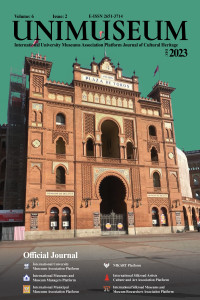Öz
Kaynakça
- Aftab. (2015, April 8). The glory of Persepolis in Canada. Archived from the original on November 4, 2012. Access date: August 6, 2011.
- Ahmadi, A. “Hz. Suleiman (a.s) and Hodhod Khosh Khabar”.
- BBC Persian. (2012). “Iranian revolution and cultural heritage.”
- Bilgi Newspaper. (1979, April 23) “Iran Ettelaat” p.1. Britannica Online Encyclopedia. “Persepolis.”
- Cultural Heritage, Crafts and Tourism Organization. (Access date: May 200, 2011). Archived from the original on February 18, 2013.
- Erbay, F. (2009). “Palmira (Tadmur) Antik Kenti.” rh+Sanat-Plastik Sanatlar Dergisi, vol.63, p.74-76. Frye, R. N. (1974). Persepolis Revisited. Journal of Ancient Persian Studies, 33(4), 383-62.
- Google Maps. (Access date: September 24, 2013). “Location of Persepolis.”
- Herzfeld, E. (n.d.). Ernst iii. Herzfeld and Persepolis. Encyclopaedia Iranica.
- Iranicaonline.org. (2008). “Iran Chronology History Part 1.”
- Rezaiyan, Farzin Haft Rukh Farrokh, Iran. P. P. 68. (2017). Alireza Shahpour Shahbazi. Persepolis Documentary Guide. Parse Pasargad Research Foundation, Tehran, Sefiran Publications, and Farhangsarai Mirdashti Publications, p. 28. ISBN 4-6-91960-964. Rouhani, B. (2005, February). “The beginning of modernism in Tehran’s architecture.” Islamika, February 18, 2013.
- Shahbazi, A. S. (2004). “The city of Parse and its position in Achaemenid history.” Documentary Guide to Persepolis, Parse Pasargad Research Foundation, Tehran, Sefiran Publications, and Mirdashti Farhangsarai Publications, p. 11. ISBN 6-4-964-91960.
Öz
Abstract
Persepolis, the capital of the Achaemenids established in 518 BC by Darius the Great, represents an architectural marvel embodying the essence of ancient Persian civilization. Enriched with historical inscriptions and cultural significance, it stands as a testament to the resilience of its people through conquests, including the invasion by Alexander the Great in 330 BC. This article delves into the historical, cultural, and architectural facets of Persepolis, exploring its UNESCO World Heritage status, Sassanid influences, and the enduring legacy encapsulated in the tombs of Naksh-e Rustam. Join us on a journey through time as we unravel the layers of Persepolis, a living chronicle of Iran's rich past.
Anahtar Kelimeler
Persepolis Achaemenid Empire UNESCO World Heritage Sassanid Influence Naksh-e Rustam
Kaynakça
- Aftab. (2015, April 8). The glory of Persepolis in Canada. Archived from the original on November 4, 2012. Access date: August 6, 2011.
- Ahmadi, A. “Hz. Suleiman (a.s) and Hodhod Khosh Khabar”.
- BBC Persian. (2012). “Iranian revolution and cultural heritage.”
- Bilgi Newspaper. (1979, April 23) “Iran Ettelaat” p.1. Britannica Online Encyclopedia. “Persepolis.”
- Cultural Heritage, Crafts and Tourism Organization. (Access date: May 200, 2011). Archived from the original on February 18, 2013.
- Erbay, F. (2009). “Palmira (Tadmur) Antik Kenti.” rh+Sanat-Plastik Sanatlar Dergisi, vol.63, p.74-76. Frye, R. N. (1974). Persepolis Revisited. Journal of Ancient Persian Studies, 33(4), 383-62.
- Google Maps. (Access date: September 24, 2013). “Location of Persepolis.”
- Herzfeld, E. (n.d.). Ernst iii. Herzfeld and Persepolis. Encyclopaedia Iranica.
- Iranicaonline.org. (2008). “Iran Chronology History Part 1.”
- Rezaiyan, Farzin Haft Rukh Farrokh, Iran. P. P. 68. (2017). Alireza Shahpour Shahbazi. Persepolis Documentary Guide. Parse Pasargad Research Foundation, Tehran, Sefiran Publications, and Farhangsarai Mirdashti Publications, p. 28. ISBN 4-6-91960-964. Rouhani, B. (2005, February). “The beginning of modernism in Tehran’s architecture.” Islamika, February 18, 2013.
- Shahbazi, A. S. (2004). “The city of Parse and its position in Achaemenid history.” Documentary Guide to Persepolis, Parse Pasargad Research Foundation, Tehran, Sefiran Publications, and Mirdashti Farhangsarai Publications, p. 11. ISBN 6-4-964-91960.
Ayrıntılar
| Birincil Dil | İngilizce |
|---|---|
| Konular | Kültürel Miras Koleksiyonları ve Yorumlamaları |
| Bölüm | Makaleler |
| Yazarlar | |
| Erken Görünüm Tarihi | 29 Aralık 2023 |
| Yayımlanma Tarihi | 29 Aralık 2023 |
| Gönderilme Tarihi | 15 Aralık 2023 |
| Kabul Tarihi | 27 Aralık 2023 |
| Yayımlandığı Sayı | Yıl 2023 Cilt: 6 Sayı: 2 |
CreativeCommons Attribtion-ShareAlike 4.0 International Licence 146271331027042
Diamond Open Access refers to a scholarly publication model in which journals and platforms do not charge fees to either authors or readers.
Open Access Statement:
This is an open access journal which means that all content is freely available without charge to the user or his/her institution. Users are allowed to read, download, copy, distribute, print, search, or link to the full texts of the articles, or use them for any other lawful purpose, without asking prior permission from the publisher or the author. This is in accordance with the BOAI definition of open access.
Archiving Policy:
http://jfhs.scientificwebjournals.com/en/pub/jfhs/lockss-manifest
Archiving is done according to ULAKBİM "DergiPark" publication policy (LOCKSS).


